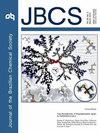通过连续种子晶体生长获得的钨酸银:结构、形态、光学和光催化性质
IF 1.3
4区 化学
Q3 CHEMISTRY, MULTIDISCIPLINARY
引用次数: 0
摘要
合成路线和参数,如合成时间、前驱体摩尔比、pH和温度对生成各种尺寸和形态的氧化物至关重要。然而,目前还没有关于如何在实验室条件下制备不同形状和大小的钨酸银(Ag2WO4)晶体而不使用硫酸酸化剂的信息。在本研究中,我们试图填补这一空白,在室温下,在不使用硫酸剂的情况下,用共沉淀法在间隔3 h的时间内制备出不同尺寸和形态的α-Ag2WO4晶体。粉末x射线衍射分析证实所有晶体都具有正交结构,而傅里叶变换红外光谱揭示了材料中原子间键的结构紊乱程度。扫描电镜结果表明,α-Ag2WO4晶体具有不同的尺寸(5.37 ~ 26.83 μm)和形态(四角形、棒状和柏叶状棒状),紫外-可见漫反射光谱分析表明,α-Ag2WO4晶体的光学带隙能(2.92 ~ 3.05 eV)采用Kubelka和Munk提出的方法计算。催化实验表明,具有最小晶体(AW1)和四棱柱形态的合成样品比其他样品更有效地降解染料(表观速率常数(k) = 5.86 × 10−3 min−1)。本文章由计算机程序翻译,如有差异,请以英文原文为准。
Silver Tungstate Obtained via Successive Seed Crystal Growth: Structural, Morphological, Optical, and Photocatalytic Properties
Synthesis routes and parameters such as synthesis time, precursor molar ratio, pH, and temperature are critical for generating oxides of various sizes and morphological aspects. However, there is no information on how to prepare silver tungstate (Ag2WO4) crystals of different shapes and sizes under laboratory conditions and without using sulfating agents. In this study, we attempted to fill this gap by preparing α-Ag2WO4 crystals of various sizes and morphologies using the coprecipitation method in a 3 h interval at room temperature and without using sulfating agents. The powder X-ray diffraction analysis confirmed that all crystals had an orthorhombic structure, whereas Fourier-transform infrared spectroscopy revealed the degree of structural disorder in the bonds between the atoms in the materials. Scanning electron microscopy revealed that the α-Ag2WO4 crystals had different sizes (5.37-26.83 μm) and morphologies (tetragonal prism, rod, and cypress leave-like rod), whereas ultraviolet-visible diffuse reflectance spectroscopy analysis indicated the optical band gap energy (2.92-3.05 eV), calculated using the method proposed by Kubelka and Munk. Catalytic tests revealed that the synthesized samples with the smallest crystals (AW1) and a tetragonal prism morphology degraded dye more efficiently (apparent rate constant (k) = 5.86 × 10−3 min−1) than other samples.
求助全文
通过发布文献求助,成功后即可免费获取论文全文。
去求助
来源期刊
CiteScore
2.90
自引率
7.10%
发文量
99
审稿时长
3.4 months
期刊介绍:
The Journal of the Brazilian Chemical Society embraces all aspects of chemistry except education, philosophy and history of chemistry. It is a medium for reporting selected original and significant contributions to new chemical knowledge.

 求助内容:
求助内容: 应助结果提醒方式:
应助结果提醒方式:


